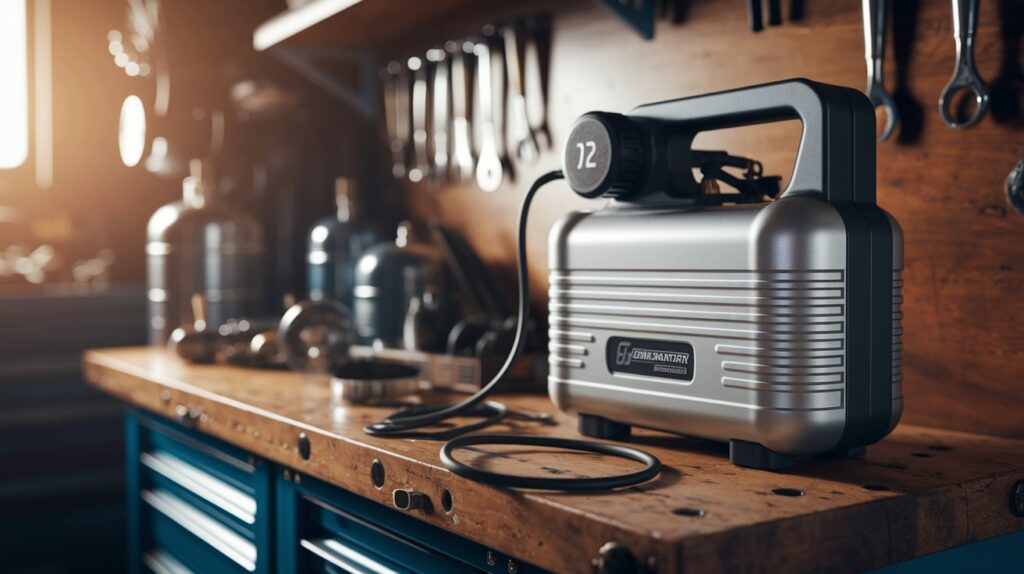Stranded with a dead car battery or a flat tire is a situation no one wants to face. Imagine being late for an important meeting or stuck in the middle of nowhere.
That’s when a jump starter air compressor becomes your lifesaver. This handy device can get your car running and your tires inflated in no time. But how do you use it effectively? We’ll guide you through the simple steps to ensure you’re never caught off guard.
You’ll discover how this tool can save your day, and why knowing how to use it is essential for every driver. Stick with us, and you’ll gain the confidence and knowledge to handle roadside emergencies with ease.
Choosing The Right Jump Starter Air Compressor
Selecting a jump starter air compressor requires understanding its use. First, connect the clamps to the battery. Then, turn on the compressor to inflate tires. Always check instructions for safety.
Choosing the right jump starter air compressor can be tricky. With many options available, understanding key features is crucial. This guide helps you make an informed choice.
Types And Features
Different types cater to varied needs. Some are compact, others are heavy-duty. Consider the features that suit your situation. Look for built-in lights for night use. A digital display can offer easy readings. An automatic shut-off prevents over-inflation.
Power And Capacity
Evaluate the power output. Ensure it’s suitable for your vehicle. Check the cranking amps. They determine starting power. Higher amps mean better performance. Capacity is also vital. Larger capacity units handle more tasks.
Portability And Design
Portability affects ease of use. Lightweight models are easier to carry. A compact design saves space. Look for a comfortable handle. It aids in transportation. A user-friendly interface simplifies operation. Design should enhance usability.
Setting Up The Jump Starter
Setting up your jump starter air compressor is crucial for effective use. A well-prepared setup ensures your device works efficiently when needed. Proper setup also enhances the longevity of your equipment. This guide walks you through the essential steps.
Initial Inspection
Begin by inspecting the jump starter. Look for physical damage or loose parts. Check the cables and connectors for wear and tear. Ensure all buttons and switches are functional. Confirm the air compressor hose is intact and not cracked.
Charging The Device
Charge the jump starter fully before use. Connect it to a power source using the provided cable. Observe the charging indicators. Wait until the device is fully charged. This ensures the device is ready for emergencies.
Safety Precautions
Always prioritize safety when handling the jump starter. Wear gloves to protect your hands. Avoid using the device in wet conditions. Keep the jump starter away from flames or heat. Read the user manual carefully for specific guidelines.
Using The Air Compressor Function
Learn how to use the jump starter air compressor efficiently. First, connect the air hose to the tire valve. Then, turn on the air compressor and monitor the pressure gauge until the desired level is reached. Ensure safety by checking connections are secure throughout the process.
When you find yourself with a deflated tire, the air compressor function of your jump starter is a lifesaver. It’s not just about inflating tires; you can pump air into sports equipment, inflatable beds, or even pool toys. This versatile tool goes beyond emergency situations, making it a handy gadget to have in your trunk. Let’s explore how you can use this function effectively.
Attaching The Hose
Start by locating the air compressor hose. It’s usually neatly tucked away in the jump starter unit.
Once you have the hose, securely attach it to the valve of the item you’re inflating.
Make sure it’s snug to prevent air leaks. A loose connection can waste your effort and time. Have you ever tried inflating a tire only to realize the hose wasn’t attached properly? Double-checking saves you from unnecessary frustration.
Setting The Pressure
Look for the pressure gauge on the jump starter air compressor.
This gauge is crucial for ensuring you pump the right amount of air.
Set the desired PSI (pounds per square inch) according to what you’re inflating. The correct PSI ensures efficiency and prevents over-inflation. Ever inflated a basketball only to find it’s rock-hard? Using the gauge helps you avoid such mishaps.
Inflating Tires And Other Items
Once everything is set, turn on the compressor.
Watch the pressure gauge as it inflates your item.
For tires, this process is quick and straightforward. The gauge helps you monitor progress and adjust if necessary. Remember, inflating sports equipment or pool toys may require different PSI settings. Have you ever wondered why your pool toy deflates quickly after inflation? It might be due to incorrect PSI. Knowing the right settings makes all the difference.
Incorporating these steps into your routine can transform minor inconveniences into manageable tasks. The air compressor function is more than a tool; it’s your ally in unexpected situations.
Jump Starting A Vehicle
Using a jump starter air compressor is straightforward. Connect the cables correctly to the battery terminals. Start the engine after ensuring the compressor is charged and ready.
Jump starting a vehicle can feel like a daunting task, especially if you’re unfamiliar with car maintenance. Yet, with a jump starter air compressor, the process becomes manageable. Whether you’re stranded in a parking lot or helping a friend, knowing how to properly jump start a car can save you time and stress. Let’s break it down step by step so you’re prepared for those unexpected moments when your car battery decides to take a break.
Identifying Battery Terminals
Before connecting anything, it’s crucial to identify the battery terminals. Most car batteries have two terminals: positive and negative.
The positive terminal is usually marked with a plus sign (+) and is often covered with a red cap. The negative terminal, on the other hand, is marked with a minus sign (-) and might have a black cap.
Make sure your car is off and the keys are out of the ignition before you begin. This ensures safety and prevents any electrical mishaps.
Connecting The Clamps
Once you’ve identified the terminals, it’s time to connect the clamps from your jump starter. Start by attaching the red clamp to the positive terminal of the dead battery.
Next, connect the black clamp to a metal, unpainted part of the car’s frame. This serves as a ground and helps prevent sparks. Avoid connecting the black clamp to the negative terminal directly, as this can cause a spark.
Ensure the clamps are secure and not touching any moving parts. This prevents any accidental disconnection or damage.
Starting The Engine
With everything connected, you’re ready to start the engine. First, power on your jump starter air compressor if it has a switch.
Try starting the car. If it doesn’t start right away, wait a minute before trying again. Sometimes, it takes a moment for the battery to gain enough charge.
If the car starts, let it run for a few minutes to allow the alternator to charge the battery. Once it seems stable, disconnect the clamps in the reverse order of how you attached them.
Have you ever successfully jump started a car? The sense of accomplishment is real, but remember, safety first. Always double-check connections and make sure your jump starter is charged before you need it.
Maintaining Your Device
Maintaining your jump starter air compressor ensures it works efficiently. It prolongs its lifespan and prevents unexpected failures. Regular upkeep is crucial for a reliable performance.
Regular Cleaning
Dust and dirt can affect your device’s function. Wipe the exterior with a soft cloth weekly. Avoid using harsh chemicals that can damage surfaces. Inspect air vents and remove obstructions. Clean connectors to ensure proper electrical contact. This reduces the risk of malfunctions.
Battery Care And Storage
Proper battery care is essential for longevity. Recharge the battery after each use. Store the device in a cool, dry place. Extreme temperatures can damage the battery. Check the battery charge monthly. Keeping it half-charged extends its life.
Troubleshooting Common Issues
Sometimes devices face minor issues. If your compressor won’t start, check the battery. Ensure connections are secure. Inspect the cables for visible damage. Replace them if necessary. If air pressure is low, check for leaks. Tighten loose fittings and test again.

Frequently Asked Questions
How Does The Air Compressor Work On A Jump Starter?
An air compressor on a jump starter inflates tires by converting electrical energy into compressed air. It utilizes the jump starter’s power to drive a piston, forcing air into the tire. This feature provides a convenient solution for inflating tires on the go, ensuring optimal tire pressure for safe driving.
Can You Run An Air Compressor Off A Car Battery?
Yes, you can run an air compressor off a car battery. Ensure the compressor is compatible with 12V power. Use a power inverter if needed for voltage conversion. Check the battery’s capacity and condition for optimal performance and avoid draining the battery completely.
Do You Connect Positive Or Negative First On An Air Compressor?
Connect the positive terminal first when attaching cables to an air compressor. This reduces the risk of sparks. Always ensure proper connection for safety and efficiency.
Do You Put Red Or Black First On A Portable Jump Starter?
Connect the red clamp to the positive terminal first. Attach the black clamp to a metal surface away from the battery.
Conclusion
Using a jump starter air compressor is simple and effective. Understand the steps to ensure safety and efficiency. Keep it handy for emergencies and regular use. Regular checks on the unit maintain its performance. Follow the instructions for better results.
A reliable tool for car enthusiasts and everyday drivers alike. Invest in one for peace of mind on the road. Remember, practice makes perfect. Try it a few times to gain confidence. It’s a smart choice for every vehicle owner.
Stay prepared, and drive with confidence and security.








